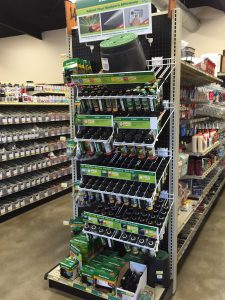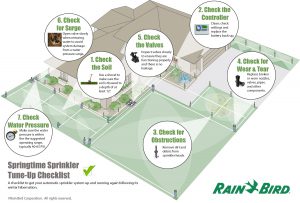Sprinkler System Tune-Up Tips & Checklist From Rain Bird
With Spring’s rains slowing down and summer temperatures heating up, now’s a good time to make sure your automatic sprinkler system is ready for another season of efficient lawn and garden watering. Just a few simple steps will go a long way towards saving water, money and preventing a mid-summer landscape catastrophe at home. Get the warm watering season off to a great start with the following tips:
Regain Control…
Run a check of the irrigation controls and programs. This includes dusting away the cobwebs on the timer, making sure the date and time is correct, and that the settings are appropriate for your landscape’s watering needs. Replace the backup battery in the timer/controller every 6 months, and keep a copy of the watering schedule nearby.
Unobstructed Flow…
Check for rocks, dirt, sand and other types of debris that may block the even flow of water from sprinkler heads. Uneven distribution can lead to too much water in some areas and not enough in others, both resulting in an unhealthy landscape and wasted water. Inspect spray heads and make sure they haven’t become buried and debris has not accumulated around them during the winter.
Out with the old…
Nozzles and sprinkler heads are designed to withstand normal wear and tear of irrigation, but are no match for errant lawn mowers, the neighbor’s dog or snowplows. Replace cracked, chipped or worn components, such as sprinkler heads, nozzles, valves or pipes. A broken sprinkler can wreak havoc on lawns, gardens, and water bills, so it is important to check and replace them periodically.
The Heart of the System…
Valves are the heart of any irrigation system. They regulate the distribution of water throughout the entire system. A leaky valve will waste water, and increase your water bill. Visually inspect each valve to make sure they are operating properly. Before turning on any water to the system, make sure all manual drain valves are returned to the closed position. Overly wet areas in the lawn, resulting in muddy and/or barren patches, may be a result of a leaky valve.
Keep The Hammer in The Tool Chest…
Water hammer is a high-pressure surge that occurs when a valve is first opened. An initial pressure surge can result in pipe bursts and damaged valves. When restoring water to your sprinkler system, open the main water valve slowly to allow pipes to fill with water in a gradual and controlled manner, thus preventing a water hammer and costly damage.
Pressure Check…
When you first turn the main water valve back on, it is important to make sure the water pressure is at a safe operating ra nge for sprinkler systems. A system with too much pressure will result in cracked pipes, busted valves, sprinkler head leaks and inefficient watering. Invest in a water pressure gauge that can be used to measure water pressure in your home and yard. These devices typically connect to a hose faucet and give you a good idea of the pressure in your irrigation system. If the pressure is above the suggested operating range (typically 40 -65 PSI), a pressure regulator may be required to prevent damage to the sprinkler system or undesirable results. For example, if water is “misting” out of your sprinkler heads, your pressure is too high and should be reduced.
nge for sprinkler systems. A system with too much pressure will result in cracked pipes, busted valves, sprinkler head leaks and inefficient watering. Invest in a water pressure gauge that can be used to measure water pressure in your home and yard. These devices typically connect to a hose faucet and give you a good idea of the pressure in your irrigation system. If the pressure is above the suggested operating range (typically 40 -65 PSI), a pressure regulator may be required to prevent damage to the sprinkler system or undesirable results. For example, if water is “misting” out of your sprinkler heads, your pressure is too high and should be reduced.
Argyle Feed & Hardware has Rain Bird sprinkler system products including replacement sprinkler heads, drip irrigation accessories, and parts. We also stock PVC pipe in various sizes and lengths as well as connectors and fittings. We are happy to help you find the parts you need to repair your automated sprinklers, visit us today!
Source: Rain Bird
